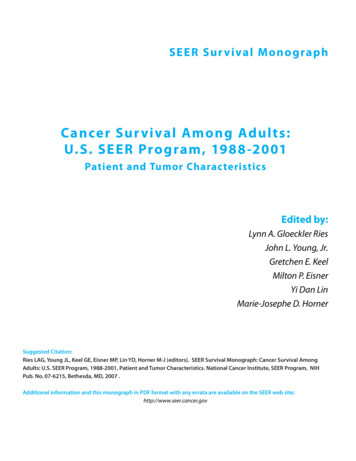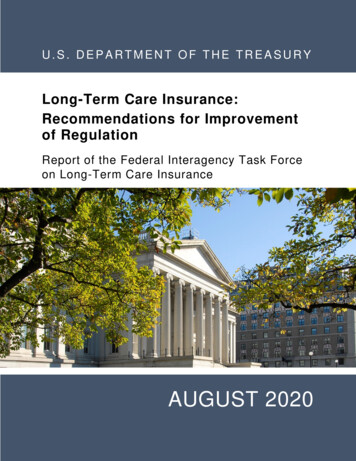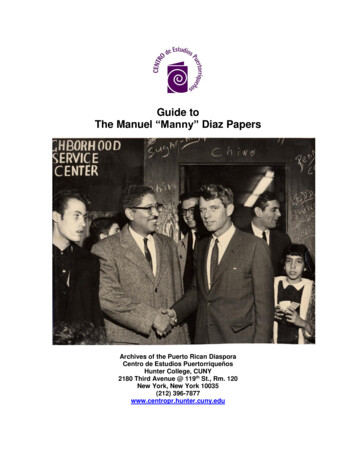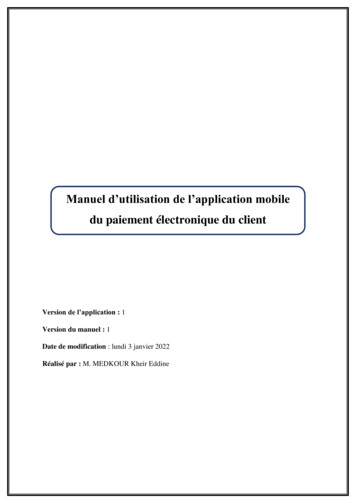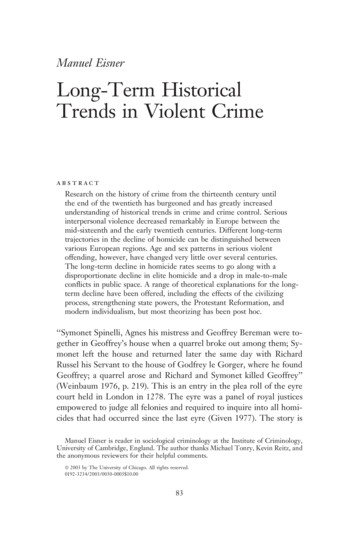
Transcription
Manuel EisnerLong-Term HistoricalTrends in Violent CrimeabstractResearch on the history of crime from the thirteenth century untilthe end of the twentieth has burgeoned and has greatly increasedunderstanding of historical trends in crime and crime control. Seriousinterpersonal violence decreased remarkably in Europe between themid-sixteenth and the early twentieth centuries. Different long-termtrajectories in the decline of homicide can be distinguished betweenvarious European regions. Age and sex patterns in serious violentoffending, however, have changed very little over several centuries.The long-term decline in homicide rates seems to go along with adisproportionate decline in elite homicide and a drop in male-to-maleconflicts in public space. A range of theoretical explanations for the longterm decline have been offered, including the effects of the civilizingprocess, strengthening state powers, the Protestant Reformation, andmodern individualism, but most theorizing has been post hoc.‘‘Symonet Spinelli, Agnes his mistress and Geoffrey Bereman were together in Geoffrey’s house when a quarrel broke out among them; Symonet left the house and returned later the same day with RichardRussel his Servant to the house of Godfrey le Gorger, where he foundGeoffrey; a quarrel arose and Richard and Symonet killed Geoffrey’’(Weinbaum 1976, p. 219). This is an entry in the plea roll of the eyrecourt held in London in 1278. The eyre was a panel of royal justicesempowered to judge all felonies and required to inquire into all homicides that had occurred since the last eyre (Given 1977). The story isManuel Eisner is reader in sociological criminology at the Institute of Criminology,University of Cambridge, England. The author thanks Michael Tonry, Kevin Reitz, andthe anonymous reviewers for their helpful comments. 2003 by The University of Chicago. All rights reserved.0192-3234/2003/0030-0003 10.0083
84Manuel Eisnertypical of the situational structure of lethal violence in thirteenthcentury London—a disagreement, a quarrel leading to a fight, and afight resulting in a death. It could arise in different situations, oftenafter drinking or over women, sometimes during a feast, but rarely premeditatedly. In two of the 145 instances of homicide recorded in theLondon eyre court rolls of 1278, the quarrel broke out after a game ofchess.For quantitatively minded historians, the completeness of the eyrecourt records, meticulously drawn up by the clerks of the justices, is atemptation to count. James Buchanan Given (1977) did this a quartercentury ago, retrieving information on over 3,000 homicides recordedin twenty eyres in seven counties of thirteenth-century England. Beyond simple counts the data also include detailed information aboutthe sex of offenders and victims, the personal relations between them,the number of cooffenders, the situations in which the events occurred,and the decisions taken by the judiciary.The counts invite attempts at estimating a homicide rate. The 145cases recorded in the 1278 London eyre court, for example, representan average of about six cases per year, as twenty-five years had elapsedsince the last convening of the court. And if the London population ofthe time was around 40,000 inhabitants, then the homicide rate—based on the cases reported to the eyre court—was around fifteen per100,000.Scientific enticements sometimes come in bunches, and Ted RobertGurr (1981) took the issue one step further in an article in this seriesentitled ‘‘Historical Trends in Violent Crime: A Critical Review of theEvidence.’’ Besides the cluster of twenty homicide rates provided byGiven (1977), he reviewed two studies that offered estimates for a fewcounties in Elizabethan England (Samaha 1974; Cockburn 1977) anda series of homicide indictments in Surrey for the period 1663–1802(Beattie 1974). Gurr plotted the some thirty estimates between about1200 and 1800 on a graph, added the London homicide rates for themodern period, and fitted an elegant S-shaped trend curve to the datapoints (see fig. 1).The curve suggested that typical rates may have been about twentyhomicides per 100,000 population in the High and Late Middle Ages,dropping to ten around 1600, and ending after an extended downswingat about one per 100,000 in the twentieth century. Gurr interpretedthis secular trend as ‘‘a manifestation of cultural change in Westernsociety, especially the growing sensitization to violence and the devel-
Long-Term Historical Trends in Violent Crime85Fig. 1.—Indicators of homicides per 100,000 population in England, thirteenth totwentieth centuries. Note: Each dot represents the estimated homicide rate for a city orcounty for periods ranging from several years to several decades. Source: Gurr 1981,p. 313.opment of increased internal and external control on aggressive behavior’’ (1981, p. 295; see also Gurr 1989). Gurr’s essay easily qualifies asone of the most influential studies in the field of history of crime research, and the suggestive figure has been frequently reproduced (e.g.,Daly and Wilson 1988, p. 276; Ylikangas 1998b, p. 10; Monkkonen
86Manuel Eisner2001). But it also has raised a large number of questions, most of whichfall into three broad categories.For one, many historians have questioned whether counting homicides documented in premodern records and comparing respectiverates over eight centuries is scientifically sound. This problem has amethodological side, including issues of how complete premodern records are, what the historical ‘‘dark figure’’ of homicide might look like,what the relationships among homicide and other forms of interpersonal violence are, what impact changing medical technologies have,and how accurate population estimates are. But some historians ofcrime also raise a more substantive problem since the comparison ofnumbers over time assumes some comparability of the underlying substantive phenomenon, namely, interpersonal physical violence. Controversy about this issue divides scholars of more cultural science inclinations from those with more behaviorist backgrounds. The formerargue that violent acts are embedded in historically specific structuresof meanings, values, and expectations and claim that considering thecultural context is essential to understanding historical manifestationsof violence. From this viewpoint, the comparison of homicide rates isfutile and misleading. Behaviorists, by contrast, argue that aggressiveinterpersonal behavior is a human universal and that counting the frequencies in manslaughter or murder gives some information about violence in everyday interactions.The second set of questions concerns the degree to which Gurr’sfindings can be generalized and specified. Although extrapolation froma few counties in England to the Western world was probably inevitable at the time when the essay was written, it required a daring assumption. More recently, however, several historians of crime have putthe hypothesis of a long-term decline in interpersonal violence to thetest. Cockburn (1991) contributed an uninterrupted series of indictedhomicide in Kent from 1560 to 1985. Possibly to his surprise, the datashowed a more or less continuous tenfold fall from around three-tosix offenses per 100,000 to a rate of 0.3–0.7 over more than 400 years.During the 1970s, Ylikangas (1976) began to examine the long-termhistory of violence in Finland. His original findings were increasinglycorroborated by a series of studies on Norway and Sweden, which suggested a coherent pattern in Scandinavia with a massive long-termdecline of homicide rates during the early modern age (Naess 1982;Österberg and Lindström 1988; Österberg 1996). Finally, Spierenburg(1996) contributed evidence about the Netherlands, primarily focus-
Long-Term Historical Trends in Violent Crime87sing on Amsterdam and covering some 700 years. The findings againcoincided with the long-term decline anticipated by Gurr, showing adrop from about fifty per 100,000 population in the fifteenth centuryto about one per 100,000 in the nineteenth century. Thus, at least forthose captivated by transhistorical numbers, there remains little doubtabout the empirical cogency of the broad picture Gurr painted. Supported by a growing flow of empirical findings, therefore, many havenow started to ask new and more detailed questions (see, e.g., Karonen2001; Monkkonen 2001; Roth 2001; Eisner 2002b). How can the quality of the data be ascertained? Can the beginning of the downturn bemore narrowly identified? Does the timing and pace of the decline differ between large geographic areas? Can processes of pacification beattributed to specific social groups? Are there sustained periods of increasing levels of homicide rates, and how do they interact with thedeclining trend?The empirical examination of these issues is intricately connectedwith the third group of questions: Why? Answering requires somemacrolevel theory of social, cultural, and political developments that isnot among the usual stock of criminological theorizing. Many criminologists, when theorizing about the effects of long-term socialchange, are primarily equipped to explain why urbanization and industrialization should lead to more crime (Shelley 1981). But they are ata loss when asked to explain declining trends. Historians of crime,however, found that their empirical observations fit surprisingly wellwith the work of the late German sociologist Norbert Elias. In his major work, The Civilizing Process (1978), Elias assumed that an interplaybetween the expansion of the state’s monopoly of power and increasingeconomic interdependence would lead to the growth of pacified socialspaces and restraint from violence through foresight or reflection(Elias 1978, p. 236). In an attempt to bridge sociological macrotheoryand psychological insight, he suggested that the average level of selfcontrol would increase to the degree that state institutions stabilize theflow of everyday interactions. Since these expectations match so wellwhat crime historians have been finding, Elias has become the majortheoretical reference for scholars who are working in the field and interested in theorizing about the long-term trend. But it is open to debate and the refinement of empirical findings precisely how far the theory of the civilizing process goes toward providing a causal frameworkfor explaining the long-term decline in lethal violence.Departing from these groups of questions, this essay is organized in
88Manuel Eisnerthree sections. Section I presents a reanalysis of quantitative estimatesof homicide rates in Europe from the Middle Ages to the present day.It is based on a much larger set of historical studies than Gurr wasable to examine and discusses the increasing degree to which we candistinguish different long-term trajectories in the decline of homicidein various European regions. Section II reviews evidence on variouscontextual factors. I examine historical evidence on sex, age, and classof violent offenders as well as studies that have examined historical patterns of the sex of homicide victims and their relationship with theoffender. Section III explores theoretical approaches used in recentscholarship for explaining these secular trends, examining how theoretical arguments match the available data and in what ways future research might help to decide between alternative approaches.I. The Secular Trend in Lethal ViolenceWhat makes any assessment of our knowledge about the long-termtrend in homicide rates relatively difficult is that relevant research hasbeen published in many different languages, sometimes in difficult-tofind specialized historical journals, and with widely varying researchquestions forming the background of scholarly work. Therefore, thissection builds on a systematic meta-analysis of more than ninety publications on premodern homicide rates in Europe as well as on a comprehensive collection of modern homicide time series in ten countries,based on national statistics and stretching over periods of more than120 years. Taken together, these data first confirm the Europe-widemassive drop—roughly by a factor of 10:1 to 50:1 over the periodfrom the fifteenth to the twentieth century—in lethal interpersonal violence first observed by Gurr on the basis of English data (1981). Second, the transition to declining homicide rates appears to have startedearliest in the northwestern parts of Europe and then to have graduallydiffused to the more peripheral regions of the continent. By the nineteenth century, therefore, homicide rates were lowest in the modernized, affluent, and urban regions of Europe, which were surrounded bya belt of high homicide rates in the periphery. By around 1950, mostEuropean countries experienced their lowest historically known levelsof homicide rates. Since then, an increasing trend has prevailed.A. Sources: History of Homicide DatabaseTo examine long-term trajectories of lethal violence, I have assembled an extensive database of serial data on homicide in Europe. The
Long-Term Historical Trends in Violent Crime89resulting ‘‘History of Homicide Database’’ is an attempt at a comprehensive collection of available quantitative information on homicideover several centuries. The database incorporates two very differenttypes of sources. National vital statistics providing annual counts ofhomicide victims probably constitute the most reliable source. In mostEuropean countries, data series start during the second half of thenineteenth century, although Swedish national death statistics were introduced in the middle of the eighteenth century (Verkko 1951). Thesecond main source are statistics on homicides known to the police orpersons accused of murder or manslaughter. Partly based on earlier research (Eisner 1995), the database for modern national homicide statistics includes ten European countries with series of annual data stretching over more than 100 years.Prior to the introduction of national statistics, however, statisticaldata on homicides accrue from the painstaking archival work of historians who scrutinize large numbers of judicial sources produced forwidely varying purposes and not originally intended for statistical analysis. Because of the fragmented judicial structure of premodern Europe, limitations on the amount of time researchers can spend in archives, and large gaps in surviving sources, we are left with a patchworkof local studies. Some of them aim at establishing long-term trends inserious violence. Many, however, are not primarily interested in estimating the frequency of homicide but aim at gaining insight, throughjudicial records, into the administration of justice, the mentalities ofhistorical epochs, and the lives of ordinary people. However, departingfrom the elegant curve boldly drawn by Gurr through some thirty estimates of homicide rates, it is worthwhile to reassess the issue of longterm trends in violent crime by using the wealth of new research onthe history of crime. Therefore, I systematically collected the resultspublished in articles and monographs in several languages that present data on premodern homicide rates. A number of recent researchreviews facilitated access to this literature ( Johnson and Monkkonen1996; Schüssler 1996; Rousseaux 1999a; Blauert and Schwerhoff 2000).The History of Homicide Database at the time of writing includesapproximately 390 estimates of premodern homicide rates based onmore than ninety publications containing relevant data (Eisner 2001).Coded variables include information about the geographical area, theperiod, the counting units (offenders, victims, and offenses), the typeof sources, the absolute number of homicide cases, the population estimates, and assessments of the quality of the data in the primary publi-
90Manuel Eisnercation. When available, I also coded the percentages of female offenders and victims and the percentage of infanticides included in the data.Although the inclusion of infanticide is not wholly satisfying, it aimsat improving comparability, since the majority of publications do notallow for separating infanticides and other killings. Three rules guidedthe coding process.First, a threshold decision had to be made about whether to includea study. I excluded studies that are explicitly based on highly selectivesources such as minor courts, that quote only approximate estimateswithout specifying the source, or that are based on extremely smallsamples. I included all studies, however, that at least present information on the respective territory covered, the type of source, and thetime period covered. If it was sufficiently clear how the informationhad been gathered, I ignored occasional warnings by the original author against using homicide counts for computing rates. Schuster(2000), for example, extensively explains why he objects to computinghomicide rates on the basis of medieval records. However, since he describes the origin of his data ( judicial proceedings) and the territorialunit to which they refer, I decided to include his data on fifteenthcentury Constance in the database.Second, some publications present time series of counts for each single year or for short subperiods. This required a rule about how toaggregate these counts into larger units in order to reduce randomvariation. Generally, I summed up counts for single years and shortsubperiods and grouped them into ten-year periods. However, someflexibility was required to take varying sample sizes into account. Thus,series for small geographic units, providing low annual numbers, wereaggregated to twenty-year intervals.Third, whenever possible I used the population estimates quoted ina publication for computing the homicide rates. If a range of population estimates was given, the lower and upper bounds were codedseparately, and the mean was used. Some publications cite counts ofhomicides without giving population estimates. In these cases I useddemographic sourcebooks like Bairoch, Batou, and Chèvre (1988) andde Vries (1984) for population data.Most data come from scholarship using one of three types ofsources. A first type encompasses lists of coroners’ inquests or bodyinspections of persons purportedly killed irrespective of whether thesuspect was identified. Spierenburg (1996), for example, has used thiskind of source in his analysis of homicide in Amsterdam. The second
Long-Term Historical Trends in Violent Crime91type of source is records on the offenders indicted and tried by a courtand constitutes the basis for the vast majority of the data included here.A third type comprises records of suspected or proscribed homicideoffenders registered by local authorities. An example here are the socalled medieval Achtbücher in German urban jurisdictions, which listpersons banished from a city because of homicide, often after they havefled from the city (see, e.g., Simon-Muscheid 1991; Schüssler 1998).Geographically, the data cluster in five large areas. Among those,England remains exceptional in respect of the wealth of sources thatcover significant territorial units and the number of excellent studies(for syntheses, see Sharpe 1984, 1988; Emsley 1996), yielding 137 estimates. Historical estimates of homicide rates start in thirteenthcentury England with the impressive analysis by Given (1977) on thecoroners’ rolls submitted to the eyre courts. Hanawalt (1979) then examined some 16,000 crimes recorded in the jail delivery rolls duringthe first half of the fourteenth century. These documents, in which thekey information (e.g., the name and residence of the victim, the typeof crime committed, and the jury’s verdict) was recorded, include almost 3,000 homicide cases. From the mid-sixteenth century onward,comprehensive studies by Beattie (1974, 1986), Cockburn (1977,1991), and Sharpe (1983, 1984) have traced the development of homicides indicted at the assize courts of several counties over extended periods of time.A second area with a wealth of data and a rich tradition of criminalhistory research is the Netherlands and Belgium. Beginning with workby Berents (1976) on crime in fourteenth-century Utrecht, severalstudies now cover medieval cities such as Antwerp (Heyden 1983) andAmsterdam (Boomgaard 1992). Studies by Rousseaux (1986) andSpierenburg (1996) provide evidence for the early modern period untilthe beginning of the nineteenth century.Since the 1980s, a large body of scholarship has emerged in Scandinavia, exploring the very homogenous judicial sources produced by acentralized and uniform judicial system in existence since the fifteenthcentury. Österberg and Lindström (1988) have examined judicial records in Stockholm and some smaller cities from 1450 to the mid-seventeenth century. Recent studies by Karonen (1995, 1999), Ylikangas(1998a, 1998b), and Ylikangas, Karonen, and Lehti (2001) have addedimpressive series of estimates for various regions in both Sweden andFinland, some of which cover more than 200 years.Fourth, a significant number of studies provide information on long-
92Manuel Eisnerterm trends in Germany and Switzerland, although both the sourcesand the judicial structures are extremely complex. Some evidencecomes from an old tradition of local studies on medieval crime andcriminal justice (Buff 1877; Frauenstädt 1881; Cuénod 1891). Muchrecent scholarship has focused on the Middle Ages with detailed studies of Cologne (Schwerhoff 1991), Constance (Schuster 1995, 2000),Nuremberg (Schüssler 1991), Olmütz (Schüssler 1994), Kraków(Schüssler 1998), Basel (Hagemann 1981; Simon-Muscheid 1991), andZurich (Burghartz 1990). The early modern period had received lessattention, but there are now growing numbers of studies on variousareas in the seventeenth and eighteenth centuries (Schormann 1974;Henry 1984; Dülmen 1985; Behringer 1990; Lacour 2000).Although somewhat less thoroughly covered than the other areas,Italy is the fifth region with a series of studies that permit empiricallybased extrapolations. Studies of medieval and renaissance cities includeBologna (Blanshei 1981, 1982), Florence (Becker 1976), and Venice(Ruggiero 1978, 1980). Romani (1980) has examined court records inlate sixteenth-century Mantova, and a fascinating study by Blastenbrei(1995) analyzes wounding reports by medical professionals and judicialrecords in late sixteenth-century Rome. Finally, a series of studies onPadova (Zorzi 1989), Citra (Panico 1991), Sardinia (Doneddu 1991),Tuscany (Sardi 1991), and Rome (Boschi 1998) yields another clusterof estimates for the late eighteenth and early nineteenth centuries before the onset of national statistics.B. How Reliable Are Estimates of Premodern Homicide Rates?Historians who analyze extensive criminal justice records usually resort to statistical counts in presenting their findings. But they disagreewhether retrieved historical data should be used to compute homiciderates, whether such numbers provide any useful information about thereal incidence of killings, and whether long-term historical comparisonis scientifically justifiable (for the recent debate, see Spierenburg 2001;Schwerhoff 2002). There are five major issues with regard to reliabilityand validity.The first is whether murder or manslaughter cases in premodernsources qualify as homicides in a modern legal sense, or whether thedata are inflated by cases that would nowadays be regarded as negligent manslaughters or accidents (see, e.g., Aubusson de Cavarlay 2001,p. 27). Legally, homicide represented a felony throughout Europesince the High Middle Ages, and definitions invariably included some
Long-Term Historical Trends in Violent Crime93notion of intentional aggression. Philippe de Beaumanoir, officer ofthe French Crown in the thirteenth century, defined homicide in thefollowing way: ‘‘Homicide: When one kills another in the heat of afight, in which tension turns to insult and insult to fighting, by whichone often dies’’ (cited in Rousseaux 1999a, p. 145). A reading of thecase descriptions in historical sources suggests that, some exceptionsnotwithstanding, most cases would qualify as criminal acts. In this vein,DeWindt and DeWindt (1981, p. 54) conclude—based on a close examination of 111 presentments of homicide in the HuntingdonshireEyre of 1286—that 90 percent were definite acts of aggression or violence.Another important issue concerns the quality of the immensely varied judicial sources used in historical analyses. Spierenburg (1996), forexample, has argued that homicide estimates based on court recordsmay yield considerable underestimates because only a fraction of offenders were captured and brought to trial. His comparison betweenbody inspection records and the judicial sources in late medieval andearly modern Amsterdam suggests that possibly as few as 10 percentof all homicides may have resulted in a suspect being brought to court(see also Boomgaard 1992; Spierenburg 1996, p. 80). Even if this is anextreme estimate, it suggests that early court records constitute selective evidence. In order to examine this issue empirically, Monkkonen(2001) recently proposed the use of capture-recapture methods, whichyield estimates of the size of the unknown underlying population ofoffenders based on comparisons between different types of sources(e.g., court records, coroners’ inquests, proscriptions, reports in diaries, or printed sources). It remains to be seen whether such a strategycan clarify the issue of historical dark figures. Yet it is uncontroversialthat the progressive shift toward more efficient prosecution has the effect of underestimating the long-term decline in lethal violence (Stone1983, p. 23).A related issue is whether homicide rates constitute a leading indicator of overall levels of violence through long historical periods (see,e.g., Schuster 2000). For present-day societies, homicide appears quiteadequately to reflect variation in overall violence. In the United Statesand Great Britain, for example, trends in assault, as measured by theNational Crime Victimization Survey, are highly correlated with fluctuations in homicide rates (Langan and Farrington 1998). Moreover,cross-national homicide rates are also significantly correlated with levels of robbery, assault, and sexual violence as measured by the Interna-
94Manuel Eisnertional Crime Victimization Survey (Eisner 2002a). Yet until recentlythere seemed to be no way directly to address this question historically since alternative data for measuring historical levels of violencewere not available. But recent research for several sixteenth- andseventeenth-century Swedish cities now suggests that time series of recorded assault and homicide are surprisingly parallel in both trendsand fluctuations (Karonen 2001). However, since historical trends forother types of violence that differ from those for homicide cannot beruled out, the subsequent analysis is based on the assumption that homicide may be cautiously construed as an indicator only of serious interpersonal violence.A fourth, somewhat overemphasized, issue concerns the variabilityof homicide rate estimates because of the small sizes of geographicunits, the small number of cases used for computing respective rates,or both (Aubusson de Cavarlay 2001). With only a handful of estimatesbased on a few killings each, this would be a serious issue. But withseveral hundred estimates, many based on large numbers of homicides,covering both urban and rural areas, and converging to coherent patterns despite heterogeneous sources, one may safely assume that thedata are not random noise. Likewise, the low precision of populationestimates, although important, should probably not be regarded as aninsurmountable issue. Better population data are important for moreaccurate estimates. Fortunately, however, my interest is not to compare differences in the magnitude of 50 or 60 percent over time, but aten- to possibly fifty-fold decline. Therefore, quite considerable inaccuracy in population estimates—especially if it is randomly distributedbetween the different studies—can be accepted.Probably the most important ‘‘distorting’’ factor in comparisons ofhomicide across long periods is the interplay between changes in thetechnology of violence and growth in medical knowledge. The lives ofa large proportion of those who died from the immediate or secondaryconsequences (e.g., internal bleeding, infections) of a wound in any society before the twentieth century could have been saved with modernmedical technology. But until recently it seemed wholly impossible toestimate the size of this effect. Monkkonen (2001), however, has proposed to use information about the elapsed time from injury to deathas a rough indicator of the potential impact of modern medical technology. He argues that most deaths occurring within the first one totwo hours after the injury are probably not preventable even withmodern medicine, while the vast majority of those occurring after
Long-Term Historical Trends in Violent Crime95twenty-four hours could be prevented by modern technology. A seriesof studies yields quite consistent results in regard to the typical timefrom assault to death before the twentieth century. In mid-nineteenthcentury New York, about one-fourth of victims died immediately andanother fourth within the first twenty-four hours (Monkkonen 2001).In seventeenth-century Castile, about 37 percent of the victims diedimmediately and another third within the first twenty-four hours(Chaulet 1997, p. 22); Spierenburg (1996) estimates that somewhat lessthan half of victims in seventeenth-century Amsterdam died immediately. Even if these estimates are far from precise, they give a roughidea about the order of magnitude, by which the lethal consequencesof violence might have declined with late twentieth-century technology. Most authors agree, however, that changes in medical technologyare unlikely to have ha
Trends in Violent Crime abstract Research on the history of crime from the thirteenth century until the end of the twentieth has burgeoned and has greatly increased understanding of historical trends in crime and crime control. Serious interpersonal violence decreased remarkably in Europe between the mid-sixteenth and the early twentieth centuries.


